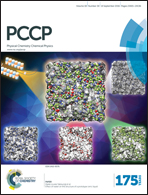Mechanochemical synthesis in the Li–Mg–N–D system under deuterium gas: a neutron diffraction study†
Abstract
The Mg(NH2)2/2LiH mixture is considered as one of the most valuable reversible hydrogen storage systems for feeding PEM fuel cells. In this paper, we investigate the mechanochemical synthesis in the Li–Mg–N–H system under deuterium gas, using Li3N and Mg as reactants, and the structural and sorption properties of the intermediate and final products mainly by means of neutron powder diffraction. Mechanochemistry leads to the end formation of amorphous Mg(ND2)2, which crystallizes upon heating above 425 K. During synthesis, a novel cation-mixed nitride/imide phase of simplified composition Li3MgN2D has been unveiled as the intermediate phase. It crystallizes in the cubic disordered anti-fluorite type structure (S.G. Fm![[3 with combining macron]](https://www.rsc.org/images/entities/char_0033_0304.gif) m) with a lattice parameter of 4.996 Å at room temperature. Deuterium absorption in this compound occurs through an original solid solution type mechanism ending with the imide compound β-Li2MgN2D2. The conjoint use of mechanochemistry under deuterium gas and in situ neutron diffraction techniques offers new avenues for better characterization of the efficient hydrogen storage materials. In particular, this work highlights the unexpected role of intermediate nitride/imide phases in the Li–Mg–N–H system.
m) with a lattice parameter of 4.996 Å at room temperature. Deuterium absorption in this compound occurs through an original solid solution type mechanism ending with the imide compound β-Li2MgN2D2. The conjoint use of mechanochemistry under deuterium gas and in situ neutron diffraction techniques offers new avenues for better characterization of the efficient hydrogen storage materials. In particular, this work highlights the unexpected role of intermediate nitride/imide phases in the Li–Mg–N–H system.


 Please wait while we load your content...
Please wait while we load your content...